Welcome back to our strategic planning series at GrowthTailor.com. This is already our 4th article in this series and it might be worth revisiting the previous ones if you have not yet seen them. Having established a thorough understanding of your current position, as described in our third article, we are now stepping into the key phase of strategic planning: Strategy Development. This phase is all about turning your creative ideas into practical actions that will steer your business towards success.
This piece of the strategic planning process is particularly exciting as it’s where imagination meets execution. We use elements of methodologies like Simon Sinek’s “Start with Why“, John Croft’s Dragon Dreaming as well as Strategy Canvas to craft strategies that are not only effective and sustainable but also deeply inspiring and ensuring competitive advantage.
Now it’s time to step back, reflect, and dream big. It’s time to think beyond the day-to-day and imagine what could be.
Why This Phase Excites Us
- Creativity Meets Strategy: This is the stage where innovative ideas are encouraged and shaped into strategies. It’s about thinking outside the box and challenging the status quo.
- Purpose-Driven Planning: Following Simon Sinek’s approach, we are digging into the ‘why’ of our business (and may be our personal ‘why’) to ensure your strategy aligns with your values and goals.
- Everyone Gets a Say: Brainstorming together we explore the concept of inclusive and participatory strategic planning. This approach ensures that the strategies developed are holistic, encompassing diverse viewpoints and fostering a sense of ownership across the organization. If useful, we could draw inspiration from John Croft’s Dragon Dreaming during this process.
What to Expect in This Phase
- Setting Clear Objectives: We guide you through setting clear, ambitious yet achievable objectives for your business.
- Building Your Strategy: Learn how to formulate strategies that leverage your strengths, address your weaknesses, and capitalize on market opportunities.
- Integrating Stakeholder Insights: Strategies are developed considering the needs and expectations of all stakeholders, ensuring a balanced and forward-thinking approach.
The Heart of Strategic Planning
Remember how we talked about the importance of strategic planning in our article “Transforming Strategic Business Planning Into a Tool for Growth“? It’s the backbone of aligning company goals with real-world actions. And it’s what we’re diving into now—turning insights into a plan of action.
So, understanding the ‘why’ behind our strategic efforts, let’s move forward and turn planning into action with the following 5 steps.
Developing Your Strategy
Embark on a journey of introspection and challenging questions to shape your strategy. Allow time for reflection; these “slow questions” require careful thought. Challenge your initial responses to ensure your strategy is robust and all-encompassing.
Step 1: Define Your Core Purpose
This is about understanding and articulating the fundamental purpose of your organisation. Inspired by Simon Sinek’s philosophy, we explore the ‘why’ behind your existence, ensuring your mission statement resonates with both internal and external stakeholders.
- Outcome: A mission statement that clearly communicates the reason for your company’s existence.
- Method: Conduct a workshop with leadership and use techniques like storytelling to draw out the essence of your business.
- Questions to ask yourself:
- What drives us to do what we do every day?
- What impact are we striving to make in our customers’ lives and the wider community?
Step 2: Clarify Your Cultural Pillars
Identify the principles that are at the heart of your company culture and operational philosophy. Your values are the guiding principles that dictate behaviour and action. They form the ethical compass of your organisation.
- Outcome: A list of the 4-7 core values that define the core beliefs of your organisation.
- Method: Engage the entire company through surveys or focus groups to find the values that resonate with everyone.
- Questions to ask yourself:
- What behaviours and principles are non-negotiable within our operations?
- How do these values guide our decision-making and define our corporate identity?
- How do you want your top-performers to behave?
Step 3: Paint Your Future
Look ahead and imagine the future you are aiming to create for your organisation. Or even better, just look around and dream. Go for a walk, leave the room and
Envision your perfect future. This step is about dreaming big and setting an ambitious yet achievable future state.
- Outcome: A vision statement that outlines the long-term success and aspirations of your company.
- Method: Future-mapping workshops that engage cross-functional teams to contribute to a shared vision. For more creativity and intense involvement of many stakeholders you can consider making use of the Dragon Dreaming’s inclusive approach. Together with the whole team you will paint a vivid picture of where the organisation is heading.
- Questions to ask yourself:
- Where do we see our company in the next decade?
- What key achievements would indicate we are realising our vision?
Step 4: Determine Your Competitive Edge
Pinpoint what differentiates your business from the competition and gives you an advantage in the market. Highlight your Strengths. Understand and use what sets your organisation apart. This step focuses on identifying the unique strengths that give you an edge in the marketplace.
- Outcome: A clear understanding of your competitive advantages that can be leveraged in your strategy.
- Method: Competitive analysis and customer feedback sessions to highlight unique selling points.
- Questions to ask yourself:
- What unique strengths do we possess that our competitors cannot replicate?
- How do these strengths reflect in our customer satisfaction and retention?
Step 5: Construct Your Strategic Path
The Strategic Blueprint: Develop the overarching strategies that will guide your company towards achieving its vision. This involves synthesizing insights from the previous steps into coherent, actionable strategies.
- Outcome: A strategic plan that outlines the key approaches your company will take to succeed.
- Method: Strategy mapping sessions, using frameworks like Porter’s Generic Strategies to outline your strategic direction.
- Questions to ask yourself:
- What strategic priorities will drive our growth and success in the coming years?
- How will we measure the effectiveness of these strategies in our operational performance?
Approaching the Strategy Development Phase
This phase involves the (executive) leaders and should engage all departments. Typically, each step can take around two weeks, including preparations and data collection. However, if feasible, bringing people together for a mini retreat can accelerate and enrich this process.
Conclusion
Developing a strategy is a thrilling journey of aligning your mission, values, vision, and strengths into a cohesive plan. As we proceed through this phase, remember that each step is an opportunity to infuse your strategy with purpose, creativity, and inclusivity.
How has the Strategic Planning Series impacted you? What have you learned, and what challenges remain? Share your journey below or reach out for a free consultation call if you’re seeking personalised support. Our aim is to help you navigate the strategic planning landscape and emerge victorious.
Stay connected for more insights and practical tips on strategic planning. Below you can subscribe to our newsletter for updates that can transform your planning into a powerful tool for growth.
[mailerlite_form form_id=6]



